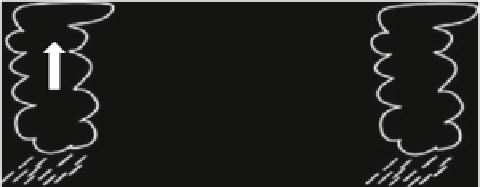Geoscience Reference
In-Depth Information
a
Mean
R
d
(z
T
)
b
d
R
d
(z
T
)<0
Perturbation
h
S,c
d
h
S,c
Change in Import
M(h
S,c
-h
S,d
) + M (h
S,c
-h
S,d
)>0
M<0 (h
S,c
-h
S,d
)>0;
(T
S,c
-T
S,d
)>0 T
S,d
<0
Import
M(h
S,c
-h
S,d
)
=
R
d
(z
T
) + F
m,h
d
d
d
d
M
d
M<0
d
d
h
S,d
F
m,h
d
h
S,c
d
h
S,d
h
S,c
Fig. 13.6
Schematic showing how negative radiative forcing by dust within the descending branch
of a direct circulation can cause cooling beneath the dust layer if aerosol forcing slows the rate of
subsidence and mass exchange M with the convecting region. The moist static energy contrast
between the convecting and descending regions, h
S;c
h
S;d
, is approximately proportional to the
surface temperature contrast T
S;c
T
S;d
. R
d
.
z
T
/ is the net downward radiation at the tropopause
and F
m;h
is the dynamical export of moist static energy to mid-latitudes by extratropical eddies
(For simplicity, F
m;h
is assumed to be unperturbed by dust) (
a
) Mean. (
b
) Perturbation
from Africa and the Arabian Peninsula. Seasonally averaged dimming of the surface
beneath the dust layer is as large as 55 Wm
2
, but the surface air temperature is
nearly unchanged, consistent with the relatively small TOA forcing and frequent
deep convection calculated by the ESM.
13.3.1.2
Temperature Adjustment in Subsiding Regions
In regions of subsidence, mixing between the surface and emitting level is relatively
weak, and radiative forcing at TOA is a weaker influence upon the surface
temperature. While temperature is relatively unchanged beneath the dust layer in
the ESM experiments of Miller and Tegen (
1998
), temperature is reduced at the
margins of the layer, even though the forcing is smaller. In these marginal regions,
deep convection is infrequent, and surface temperature is not directly coupled to
the emitting value higher in the column. Instead, this cooling is attributed to the
weakening of the tropical overturning circulation by dust (Miller and Tegen
1999
),
illustrated schematically in Fig.
13.6
where the change in overturning strength is
represented by ıM . The overturning slows so that reduced adiabatic warming
associated with descent compensates the increased radiative heating within the dust
layer. (This compensation between the overturning strength and the atmospheric
forcing assumes that changes to the stratification by dust are of secondary impor-
tance to the anomalous adiabatic heating.) Because the TOA forcing is near zero,
the export of energy from the precipitating region is unperturbed. This export is
roughly proportional to the product of the overturning strength and the surface
temperature contrast between the precipitating and subsiding regions (Miller and
Tegen
1999
). To compensate the reduction of the subsidence rate (ıM < 0),
the surface of the subsiding region must cool compared to the convecting region,














Search WWH ::

Custom Search